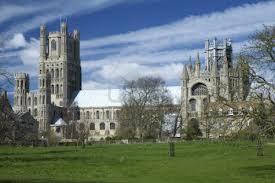
Most of what is known of the early history of Ely is derived from the “Ecclesiastical History of the English People” by the Venerable Bede and from the “Liber Eliensis”, an anonymous chronicle written in Ely in the 12th C. Between these two books, we know the history of the Abbey and the Cathedral from 673 until the mid-12th C. The monastery at Ely was founded by a woman.
Etheldreda was the daughter of Anna, king of East Anglia. She was married to an ealdorman and may have been given the Isle of Ely as a gift from her husband. When she was widowed, she retired there. In 660, for political reasons, she was married to the teenage king of Northumbria. He agreed in the beginning she should remain a virgin but later wanted a normal marital relationship. Etheldreda refused and left her young husband to become a nun at Coldingham. She went on to found a monastery at Ely in 673.
Etheldreda restored an old church at Ely but it was destroyed by Penda, a pagan king of the Mercians. She then built her monastery on the site of what is now Ely Cathedral. When she died, a shrine was built to her and it became a popular destination of medieval pilgrims. This monastery was to flourish for two hundred years until it was destroyed during the Danish invasions of the ninth century. A new Benedictine monastery was built and endowed on the site by Athelwold, Bishop of Winchester in 970.
The present cathedral was started by Abbot Simeon (brother of Walkelin who was the Bishop of Winchester) under William the Conqueror in 1083. Construction continued under Simeon’s successor. The Anglo-Saxon church was demolished and some of the relics and remains of benefactors were moved into the new building. The church was to become a cathedral in 1109. The main transepts, crossing the nave below the tower are the oldest surviving part of the cathedral. Construction was ongoing throughout most of the 12th C. and there were additions and changes to the building into the 13th C.


In 1321, work was begun on an immense, free-standing Lady Chapel. On the night of February 12, 1322, possibly due to instabilities caused by the digging of the foundations for the Lady Chapel, the great Norman crossing tower collapsed. No one was injured but the first four bays of the Early Gothic choir were damaged. These bays were rebuilt in a more modern style and the old crossing tower was replaced by an octagonal lantern which was completed by 1340. The windows on the sides of the upper octagon allow light to come into the center of the cathedral. Sometime during the first half of the 15th C. the northwest transept may have collapsed.
The Cathedral suffered only minor damage during the Dissolution of the Monasteries in 1539. Some of the carvings and glass were destroyed along with the statues from the Lady Chapel. However, the shrine of St. Etheldreda was completely demolished. A slate in the cathedral marks the spot where it stood. The cathedral was re-founded in 1541.
The Bishop of Ely in the mid-17th C. was Matthew Wren, an uncle of Sir Christopher Wren, the architect of the new St. Paul’s Cathedral in London. Sir Christopher designed a splendid Gothic door on the north face of Ely Cathedral. The building was the subject of other restoration projects, most notably twice in the 18th C. During a remodeling in 1839, the architect Elias George Besevi died in a fall from the west tower. A painted wooden ceiling was added to the nave during this restoration. The last renovation project lasted from 1986 to 2000.
Reblogged this on History's Untold Treasures and commented:
H/T The Freelance History Writer
LikeLike
Quite the eclectic history of a building, or at least the history of this church. Truly stunning looking building.
LikeLike